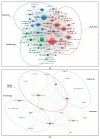A Bibliometric Analysis of the Global Trend of Using Alginate, Gelatine, and Hydroxyapatite for Bone Tissue Regeneration Applications
- PMID: 33671617
- PMCID: PMC7927100
- DOI: 10.3390/polym13040647
A Bibliometric Analysis of the Global Trend of Using Alginate, Gelatine, and Hydroxyapatite for Bone Tissue Regeneration Applications
Abstract
Collecting information from previous investigations and expressing it in a scientometrics study can be a priceless guide to getting a complete overview of a specific research area. The aim of this study is to explore the interrelated connection between alginate, gelatine, and hydroxyapatite within the scope of bone tissue and scaffold. A review of traditional literature with data mining procedures using bibliometric analyses was considered to identify the evolution of the selected research area between 2009 and 2019. Bibliometric methods and knowledge visualization technologies were implemented to investigate diverse publications based on the following indicators: year of publication, document type, language, country, institution, author, journal, keyword, and number of citations. An analysis using a bibliometric study found that 7446 papers were located with the keywords "bone tissue" and "scaffold", and 1767 (alginate), 185 (gelatine), 5658 (hydroxyapatite) papers with those specific sub keywords. The number of publications that relate to "tissue engineering" and bone more than doubled between 2009 (1352) and 2019 (2839). China, the United States and India are the most productive countries, while Sichuan University and the Chinese Academy of Science from China are the most important institutions related to bone tissue scaffold. Materials Science and Engineering C is the most productive journal, followed by the Journal of Biomedical Materials Research Part A. This paper is a starting point, providing the first bibliometric analysis study of bone tissue and scaffold considering alginate, gelatine and hydroxyapatite. A bibliometric analysis would greatly assist in giving a scientific insight to support desired future research work, not only associated with bone tissue engineering applications. It is expected that the analysis of alginate, gelatine and hydroxyapatite in terms of 3D bioprinting, clinical outcomes, scaffold architecture, and the regenerative medicine approach will enhance the research into bone tissue engineering in the near future. Continued studies into these research fields are highly recommended.
Keywords: alginate; bone tissue; gelatine; hydroxyapatite; scaffold.
Conflict of interest statement
The authors declare no conflict of interest.
Figures







Similar articles
-
Bone regeneration materials and their application over 20 years: A bibliometric study and systematic review.Front Bioeng Biotechnol. 2022 Oct 5;10:921092. doi: 10.3389/fbioe.2022.921092. eCollection 2022. Front Bioeng Biotechnol. 2022. PMID: 36277397 Free PMC article.
-
Research Trends in the Application of Artificial Intelligence in Oncology: A Bibliometric and Network Visualization Study.Front Biosci (Landmark Ed). 2022 Aug 31;27(9):254. doi: 10.31083/j.fbl2709254. Front Biosci (Landmark Ed). 2022. PMID: 36224012
-
Deciphering the focuses and trends in skin regeneration research through bibliometric analyses.Front Med (Lausanne). 2022 Jul 22;9:947649. doi: 10.3389/fmed.2022.947649. eCollection 2022. Front Med (Lausanne). 2022. PMID: 35935762 Free PMC article.
-
Knowledge domain and hotspots concerning photosensitive hydrogels for tissue engineering applications: A bibliometric and visualized analysis (1996-2022).Front Bioeng Biotechnol. 2022 Nov 14;10:1067111. doi: 10.3389/fbioe.2022.1067111. eCollection 2022. Front Bioeng Biotechnol. 2022. PMID: 36466359 Free PMC article.
-
Application of piezoelectric materials in the field of bone: a bibliometric analysis.Front Bioeng Biotechnol. 2023 Aug 4;11:1210637. doi: 10.3389/fbioe.2023.1210637. eCollection 2023. Front Bioeng Biotechnol. 2023. PMID: 37600300 Free PMC article. Review.
Cited by
-
Hydroxyapatite-Based Natural Biopolymer Composite for Tissue Regeneration.Materials (Basel). 2024 Aug 20;17(16):4117. doi: 10.3390/ma17164117. Materials (Basel). 2024. PMID: 39203295 Free PMC article. Review.
-
Polysaccharides-Calcium Phosphates Composite Beads as Bone Substitutes for Fractures Repair and Regeneration.Polymers (Basel). 2023 Mar 17;15(6):1509. doi: 10.3390/polym15061509. Polymers (Basel). 2023. PMID: 36987289 Free PMC article.
-
Fabrication and evaluation of a host-guest polylactic acid/gelatin-hydroxyapatite-blueberry scaffold for bone regeneration.J Orthop Surg Res. 2025 Aug 22;20(1):788. doi: 10.1186/s13018-025-06166-4. J Orthop Surg Res. 2025. PMID: 40847359 No abstract available.
-
Extraction of natural hydroxyapatite for biomedical applications-A review.Heliyon. 2022 Aug 22;8(8):e10356. doi: 10.1016/j.heliyon.2022.e10356. eCollection 2022 Aug. Heliyon. 2022. PMID: 36082327 Free PMC article. Review.
-
3D bioprinting technology to construct bone reconstruction research model and its feasibility evaluation.Front Bioeng Biotechnol. 2024 Jan 19;12:1328078. doi: 10.3389/fbioe.2024.1328078. eCollection 2024. Front Bioeng Biotechnol. 2024. PMID: 38314351 Free PMC article.
References
-
- O’Brien F.J. Biomaterials and scaffolds for tissue engineering. Mater. Today. 2011;14:88–95. doi: 10.1016/S1369-7021(11)70058-X. - DOI
Publication types
LinkOut - more resources
Full Text Sources
Other Literature Sources

